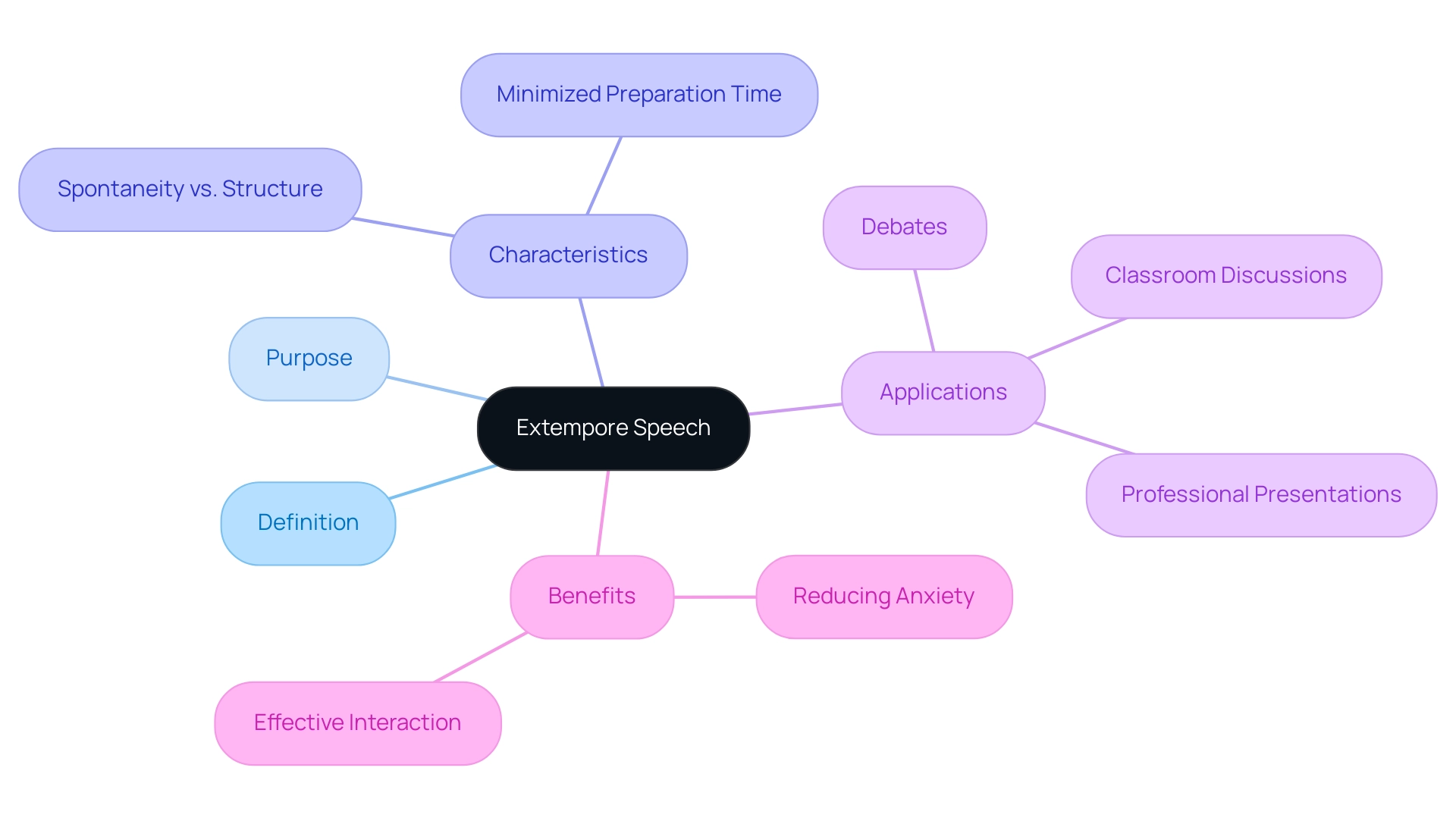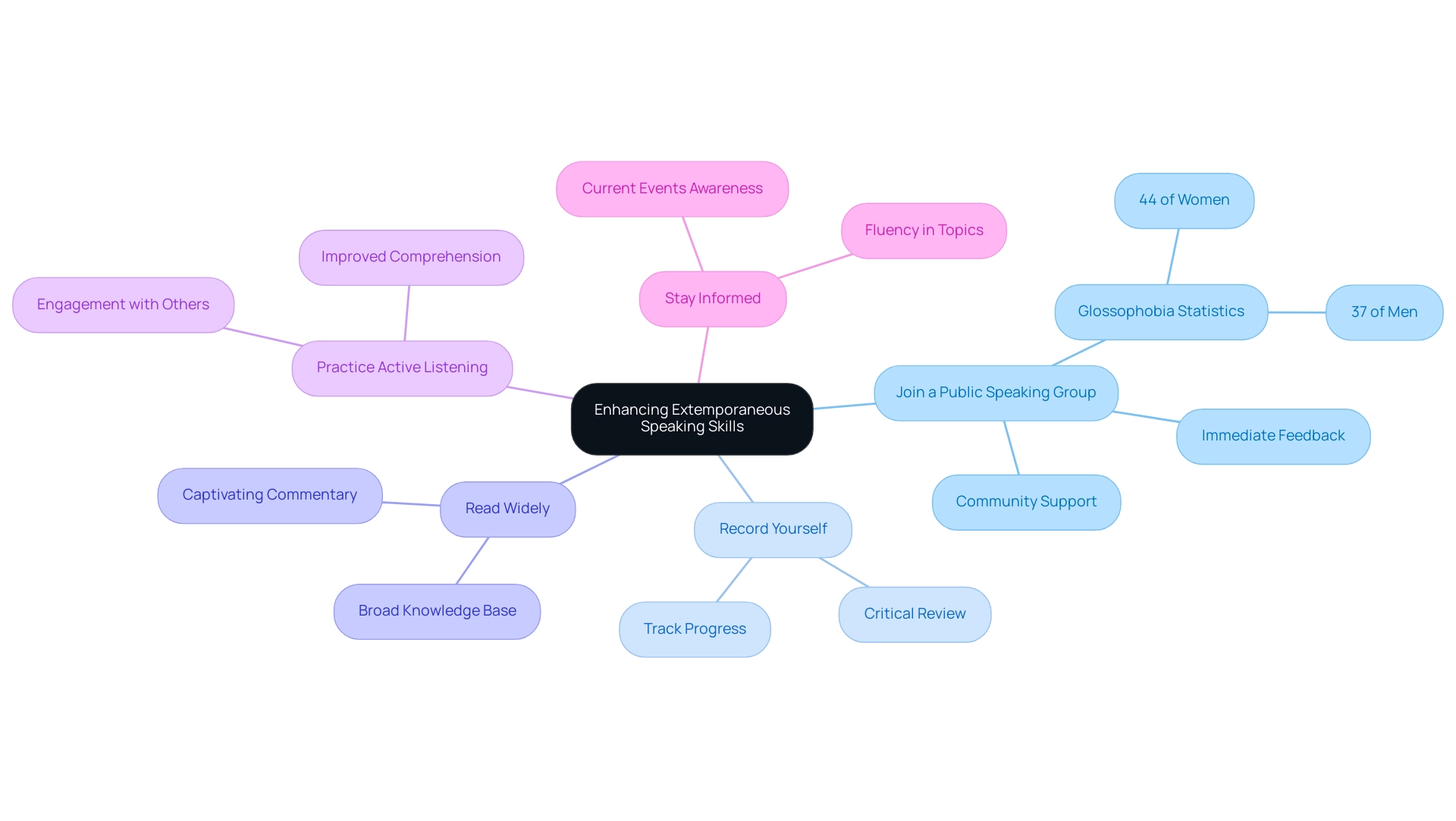Introduction
Public speaking often evokes a mix of excitement and apprehension, particularly when it comes to extemporaneous speech—a unique form of public speaking that requires delivering content with minimal preparation. This article delves into the intricacies of extemporaneous speaking, exploring its:
- Definition
- Key elements for success
- Practical strategies for effective delivery
By understanding the importance of:
- Structure
- Clarity
- Engagement
- Confidence
Individuals can enhance their speaking skills and connect more effectively with their audience. Furthermore, addressing common pitfalls and incorporating actionable tips can empower speakers to overcome anxiety and improve their overall performance. Whether in a classroom, professional setting, or public forum, mastering extemporaneous speech can significantly impact one’s ability to communicate ideas clearly and persuasively.
1. Understanding Extemporaneous Speech: Definition and Purpose
Extempore speech represents a distinctive form of public communication where the speaker delivers content with minimal preparation time. The core objective of an extempore speech is to engage the audience—typically between 50 to 100 members—by presenting spontaneous yet coherent ideas on a specific topic. Unlike impromptu delivery, which is characterized by its complete lack of prior planning, extempore speech permits a degree of premeditated thought.
This balance of spontaneity and structure is crucial for an extempore speech, as it enhances the speaker's ability to convey clear messages while adapting to the dynamics of the moment. This method proves particularly beneficial in various settings, such as debates, classroom discussions, and professional presentations, where the ability to perform an extempore speech in real-time is essential. Moreover, recent research indicates that
public communication anxiety can adversely affect academic performance, with many students hesitating to participate in class presentations.
As noted, 'They can provide strategies and techniques to help individuals overcome their fear,' highlighting the importance of developing skills in extempore speech. Additionally, the case study titled 'Creating a Harmonious Day: The Role of Routines in Autism' underscores the significance of structure and routine, which parallels the structured spontaneity required in extempore speech. Cultivating these skills can not only reduce anxiety but also enable individuals to interact effectively with their listeners.
2. Key Elements of an Effective Extemporaneous Speech
An effective extemporaneous presentation is built upon several essential elements:
-
Structure: A well-defined introduction, body, and conclusion serve to organize the speaker's thoughts and facilitate understanding of the message. A coherent structure not only aids in clarity but also enhances the overall effectiveness of the speech.
-
Clarity: Employing straightforward language while avoiding technical jargon ensures that individuals can grasp the key points easily, promoting better understanding and retention of the information presented.
-
Engagement: The use of eye contact, purposeful gestures, and vocal variety are crucial in maintaining listener interest. Engaged listeners are more likely to absorb the speaker's message, as highlighted by recent studies indicating that effective communication can significantly increase participant involvement. Notably, body language accounts for 55% of communication effectiveness, underscoring its importance in engaging listeners.
-
Relevance: It is imperative that the content presented directly relates to the interests of the listeners and the topic being discussed. Customizing the speech to meet these expectations fosters a stronger connection and enhances the listeners' receptiveness. Given that 48.12% of people experience mild impairment, 30% moderate impairment, and 21.98% serious impairment due to fear of public speaking, addressing these concerns is vital for effective communication.
-
Confidence: Demonstrating assurance during presentation can significantly affect how listeners perceive the presenter and their message. A self-assured posture comforts the listeners about the presenter's expertise on the topic, thus enhancing the chances of a favorable response. According to a survey conducted by Speakerflow, about 33% of public presenters are growing their business by hiring staff or contractors, reflecting current trends in public communication that emphasize the significance of audience engagement. Incorporating these elements not only contributes to a compelling speech but also aligns with these trends.
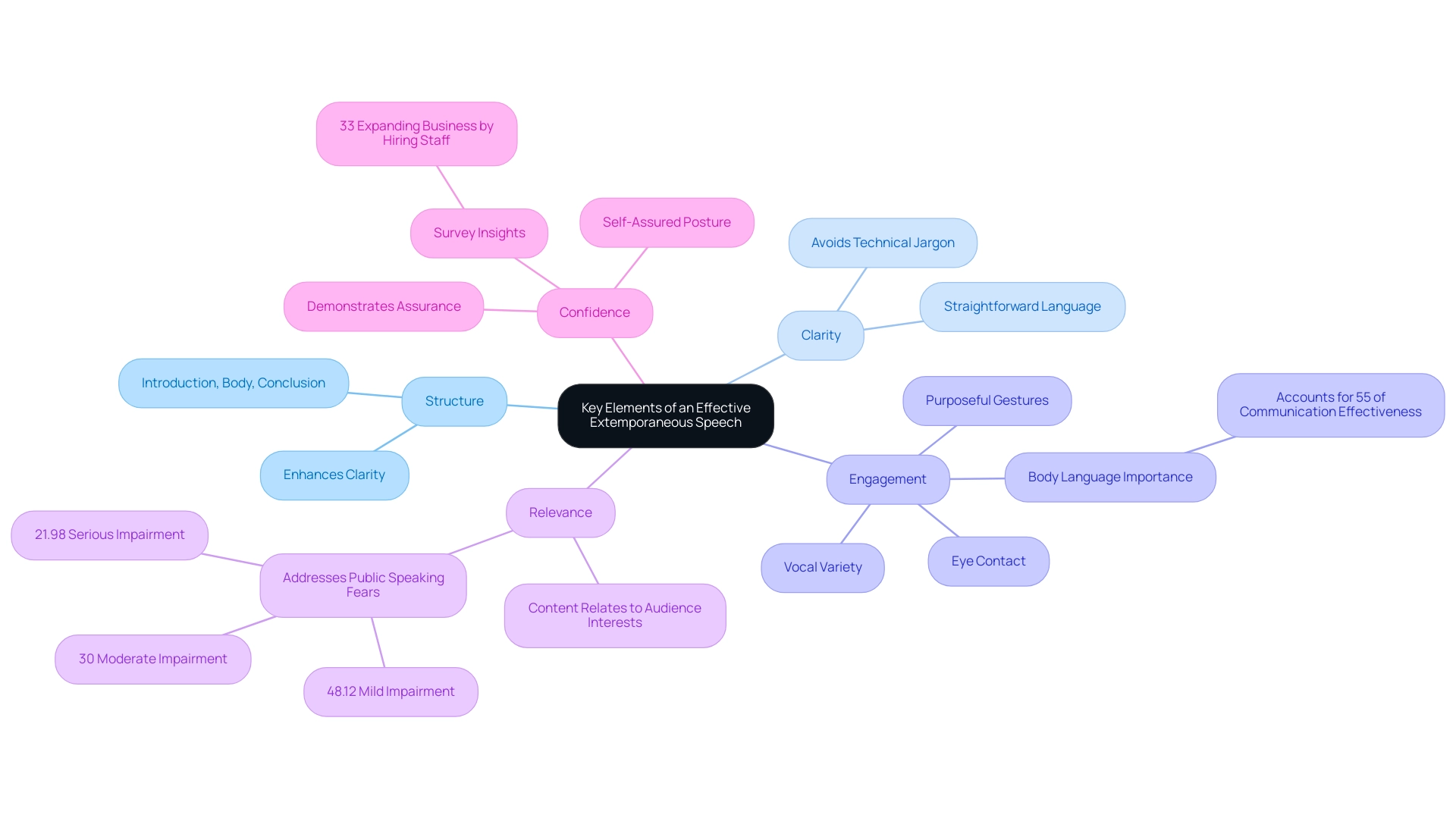
3. Step-by-Step Guide to Delivering an Extemporaneous Speech
-
Choose Your Topic: When selecting a topic, aim for one that evokes your passion or aligns with your expertise. Delivering an extempore speech on subjects you are knowledgeable about not only enhances your confidence but also allows for a more engaging presentation. Additionally, remember that 70% of speakers use some form of referral marketing to source leads, highlighting the importance of networking in building your speaking opportunities.
-
Gather Your Thoughts: Allocate a few moments to outline the key points you intend to discuss. Reflect on the core message you wish to convey to those you are addressing, as clarity in your objectives will facilitate a more coherent delivery.
-
Organize Your Presentation: Structure your presentation effectively by following a clear format: start with a compelling introduction, proceed with well-defined main points in the body, and conclude with a powerful closing statement that reinforces your message. For instance, start with an attention-grabbing hook to captivate your listeners right away.
-
Practice: Rehearse your presentation aloud, even if you do not have a script. This practice not only familiarizes you with the content but also enhances your delivery and timing for an extempore speech. The more you practice, the more comfortable you will feel during the actual presentation.
-
Manage Nerves: Employ techniques such as deep breathing or visualization exercises to alleviate anxiety before stepping onto the stage. Acknowledging that nervousness is a common experience among speakers—44% of women and 37% of men reportedly struggle with glossophobia—can help normalize your feelings and prepare you mentally. Furthermore, consider the findings from the case study titled 'Factors Contributing to Public Speaking Fear,' which indicates that 30% of students' fear of extempore speech is linked to perceived listener attitudes, while 23% stems from difficulties in recalling information during speeches. Understanding these factors can help you better manage your nerves and improve your delivery.
-
Deliver with Confidence: Adopt a confident posture by standing tall, establishing eye contact with those present, and incorporating appropriate gestures. Concentrate on conveying your message rather than worrying about audience perception. Remember, effective delivery is a key component of successful public speaking. Additionally, mastering these skills can lead to significant career benefits, as professionals can expect to earn between $50,000 and $75,000 annually, opening doors to various revenue sources including keynoting, workshops, and digital products.
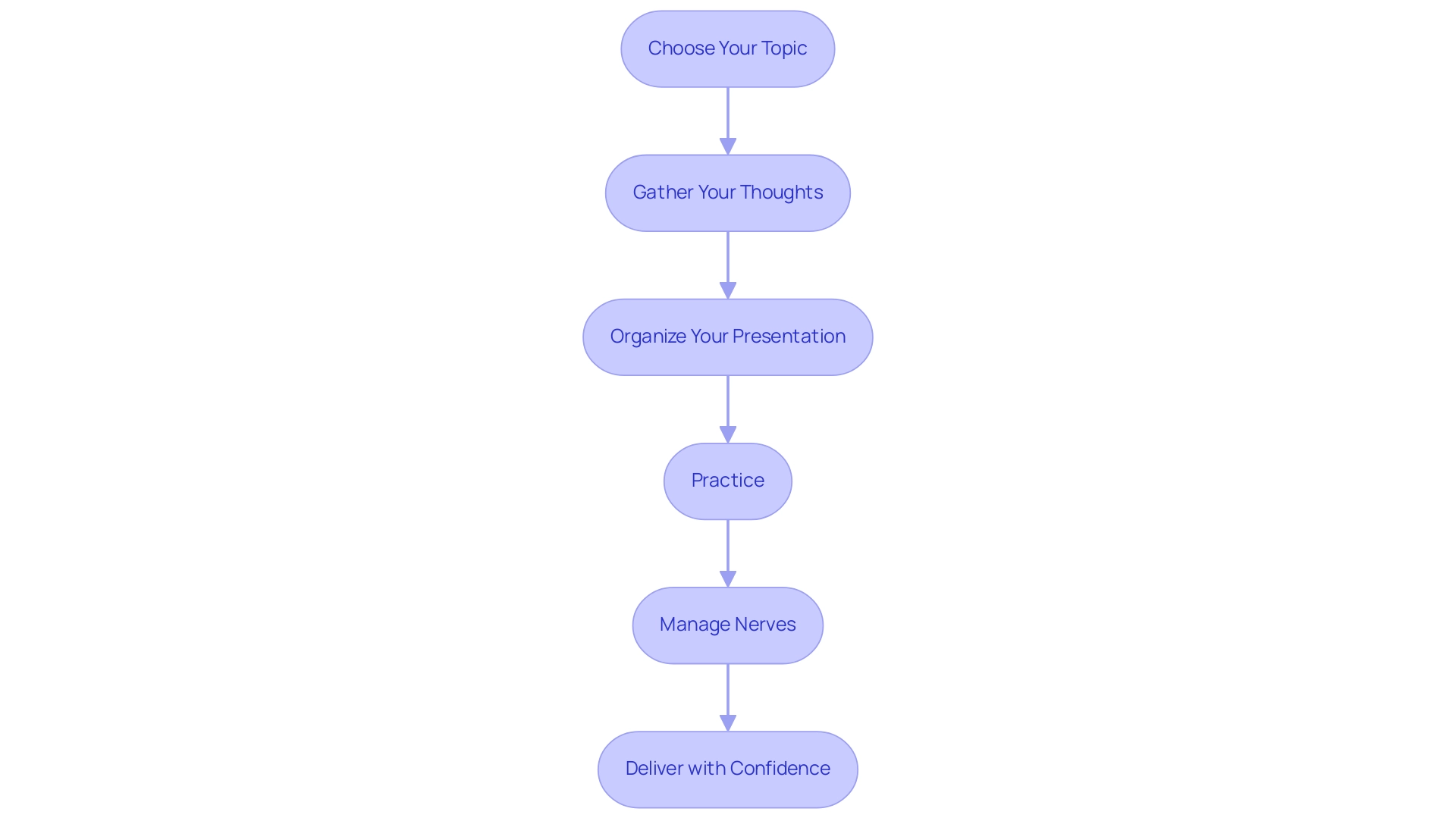
4. Common Mistakes to Avoid in Extemporaneous Speaking
-
Overloading Information: One significant mistake speakers often make is cramming excessive information into their presentations. This can lead to confusion and disengagement among the spectators. To maintain clarity, focus on a few key points that effectively convey your message. This approach not only enhances understanding but also aids retention.
-
Neglecting the Viewers: Engaging with your spectators is crucial for maintaining their interest. Failure to consider their perspectives and interests can result in disconnection. Skilled communicators make a deliberate effort to comprehend their listeners, adjusting their delivery to connect with them. In fact, with 7.9% of the U.S. population experiencing
social anxiety disorder, it is vital to create a comfortable environment for all attendees. Moreover, with 59,976 board-certified behavior analysts (BCBAs) in the U.S., speakers can benefit from insights into engagement strategies that these professionals utilize to connect with diverse groups.
-
Poor Time Management: Managing your speaking time effectively is essential for keeping your listeners engaged. Practicing your presentation will help you gauge its length and ensure you stay within your allotted time. This not only respects the time of those present but also enhances the overall effectiveness of your delivery.
-
Lack of Structure: A well-organized presentation is critical for clarity. Without a clear flow, audiences may struggle to follow your points, leading to confusion. Organize your content logically, using signposts to guide your listeners and emphasize the connections between your ideas.
-
Ignoring Feedback: After delivering your speech, seeking constructive feedback is essential for growth in communication. Disregarding this feedback can hinder your development and limit your effectiveness in future presentations. Embrace insights from others to refine your skills and avoid repeating common mistakes. Recent discussions in public presentation circles highlight that many speakers fail to incorporate feedback, which can stifle their improvement and adaptability. Additionally, drawing from case studies, such as "Exploring the Complexities of Autism Parenting," can provide valuable lessons on understanding audience needs and crafting effective communication strategies.
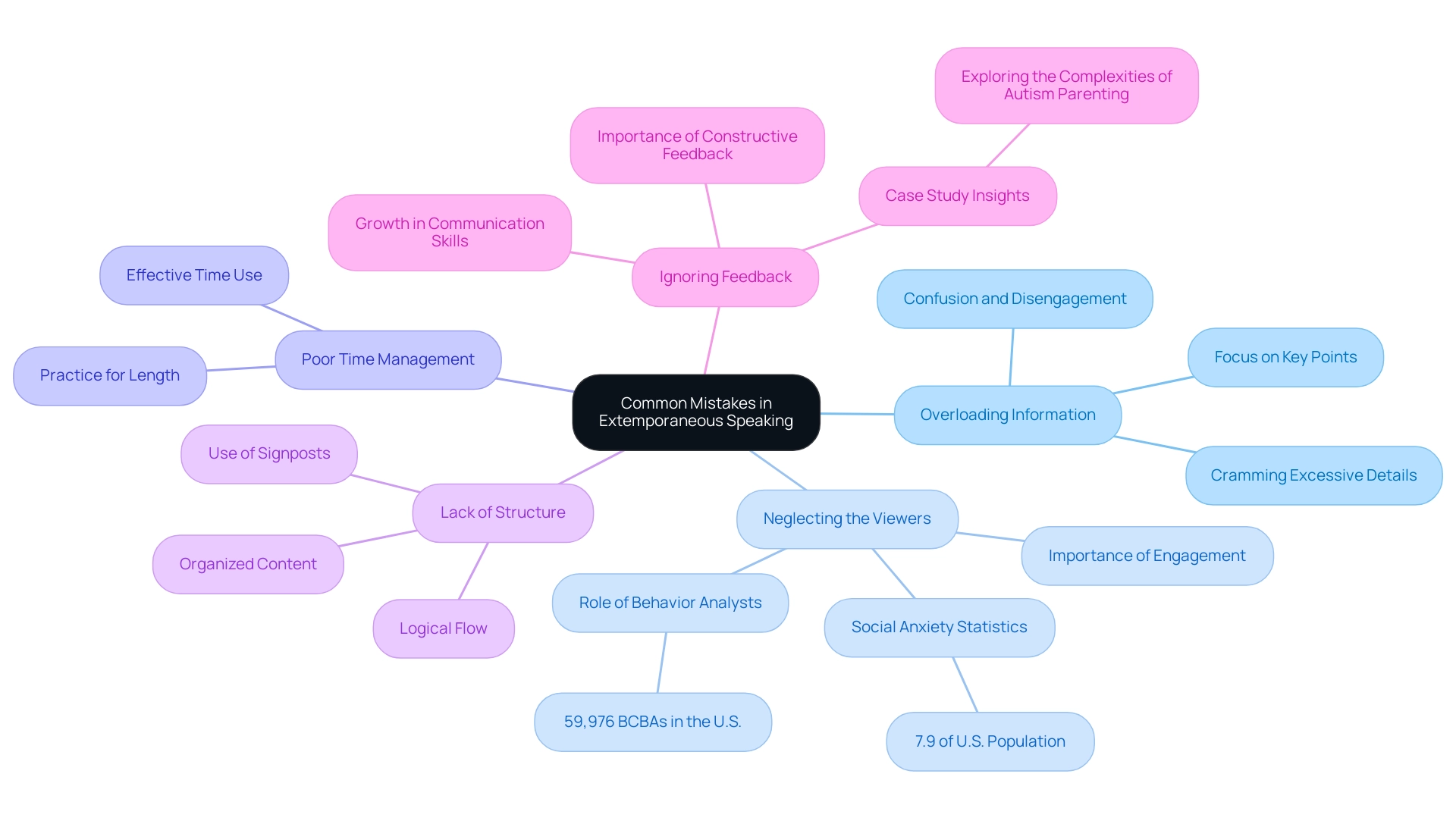
5. Tips for Enhancing Your Extemporaneous Speaking Skills
-
Join a Public Speaking Group: Organizations such as Toastmasters offer a constructive environment where individuals can practice and enhance their speaking skills. These groups not only provide immediate feedback but also foster a sense of community, crucial for those
suffering from glossophobia—44% of women and 37% of men experience this fear, which often hinders their communication abilities. Moreover, with 67% of speakers acting as solopreneurs, joining such groups can also help build long-term relationships and utilize content marketing to generate leads.
-
Record Yourself: Recording your speeches allows for a critical review of your delivery and content. This practice can reveal areas needing improvement and help track your progress over time. Feedback from these recordings can be invaluable in refining your style.
-
Read Widely: A broad knowledge base enables you to draw upon various subjects during extempore speech. Interacting with varied materials improves your skill to captivate listeners and offer insightful commentary.
-
Practice Active Listening: Engaging with the speeches of others sharpens your ability to think on your feet and respond spontaneously. Active listening not only improves your comprehension but also enhances the depth of your contributions during discussions.
-
Stay Informed: Keeping abreast of current events and trending topics increases your fluency in a range of subjects, empowering you to speak with confidence and authority. This awareness is crucial for effective extempore speech, allowing you to relate contemporary issues to your audience.
Furthermore, a survey by Speakerflow indicates that about 33% of public speakers are expanding their business ventures by hiring employees or contractors, underscoring the professional advantages of developing strong presentation skills. Additionally, fear of public presentation can cause significant impairment, with 48.1% experiencing mild impairment, 30% moderate impairment, and 21.9% serious impairment. Recording your speeches and participating in public speaking groups can significantly enhance your confidence and effectiveness, as evidenced by numerous success stories from Toastmasters members.
Conclusion
Mastering extemporaneous speech is a valuable skill that can greatly enhance one's ability to communicate effectively in various settings. This article has explored the essential components that contribute to successful extemporaneous speaking, including:
- The importance of structure
- Clarity
- Engagement
- Relevance
- Confidence
Each of these elements plays a pivotal role in ensuring that messages are conveyed clearly and resonate with the audience.
Effective delivery of an extemporaneous speech requires careful preparation and practice. By choosing relevant topics, organizing thoughts coherently, managing nerves, and maintaining a confident demeanor, speakers can significantly improve their performance. Additionally, avoiding common pitfalls such as:
- Information overload
- Neglecting audience engagement
- Poor time management
is crucial for maintaining audience interest and ensuring clarity.
Ultimately, enhancing extemporaneous speaking skills is not only about overcoming anxiety but also about developing a powerful means of connection with audiences. Engaging in public speaking groups, recording oneself, and staying informed on current topics are practical steps that can lead to ongoing improvement. Embracing these strategies can empower individuals to communicate their ideas persuasively and confidently, making a lasting impact in both personal and professional arenas.
